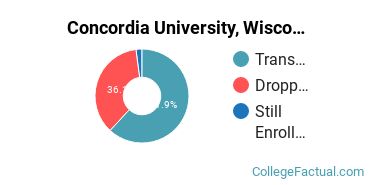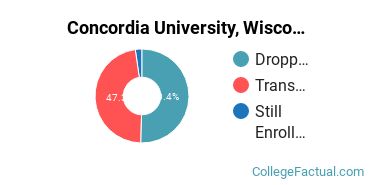 by our College Data Analytics Team
by our College Data Analytics TeamMake an informed decision about your education by understanding Concordia University, Wisconsin retention and graduation rates. First year retention rates let you know how many first-time, full-time students students come back for their second year. Graduation rates tell you how many students complete their degree and how long it takes.
The freshmen retention rate applies to first-time / full-time students who come back for their second year.
With 81% students making it past their freshmen year, Concordia University, Wisconsin has freshmen retention rates above the national average.
Nationwide, the average first to second year retention rate is 70.57%.
When looking at just colleges and universities in Wisconsin, the average is 74.47%.

| Retention Rate | |
|---|---|
| Concordia University, Wisconsin | 81% |
| Nationwide | 70.57% |
| Wisconsin | 74.47% |
There were approximately 826 students in the class of 2015. How many of them actually completed their degree in a timely fashion?
38% of the cohort completed their degree in four years, 50% in six years, and 52% in eight years.
Any student who completes their bachelor's degree within six years is considered to have graduated on time, according to the National Center for Education Statistics. This makes the offical Concordia University, Wisconsin graduation rate 50%.
The typical Concordia University, Wisconsin student takes 4.27 years to complete their bachelor's degree.


| Completion Within | Undergraduates | Percentage |
|---|---|---|
| Four Years | 710 | 43% |
| Six Years | 826 | 50% |
| Eight Years | 28 | 2% |
| Did Not Complete | 804 | 48% |
Approximately 804 students or 48% of the cohort did not complete their degree within eight years.
What happened to the 804 students who did not complete their degree?
0 are still enrolled.
479 transferred to another institution.
Concordia University, Wisconsin lost contact with the remaining 314 who we assumed dropped out.

| Non-Completions | Undergraduates | Percentage |
|---|---|---|
| Still Enrolled | 0 | 0.0% |
| Transferred | 479 | 59.6% |
| Dropped Out | 314 | 39.1% |

| Race/Ethnicity | Graduation Rate |
|---|---|
| American Indian or Alaskan Native | 33% |
| Asian | 71% |
| Black / African-American | 19% |
| Hawaiian | 100% |
| Hispanic | 50% |
| International | 38% |
| Multi-Ethnic | 46% |
| White | 65% |
First-time, full-time students under the age of 25 are much more likely to graduate in four years. Some schools cater to mostly traditional students while others cater to 'non-traditional' students. So called 'non-traditional' students include part-time students or those who may be returning after an absense. It is common for part-time and/or adult students to take longer to graduate.
Traditional Students:
First-time, full-time students under the age of 25.
Non-Traditional Students:
Any student that is not first-time, full-time, and under the age of 25.
The majority of students at Concordia University, Wisconsin are considered 'traditional students' who are first-time attending full-time.
Examining the graduation rates of the specific cohorts shown below may be more revealing than looking at the overall graduaton rates.
First-time / full-time students at Concordia University, Wisconsin represent 35% of the students in the class of 2015, and 37.77% of Concordia University, Wisconsin bachelor's degree graduations.
With a four-year graduation rate of 38%, first-time students in the Concordia University, Wisconsin class of 2015 who attended classes full-time were more likely than average to graduate on time.
After six years, the Concordia University, Wisconsin graduation rate was 53%, and by the eight year mark, 54% of the cohort had completed their degree.
Nationwide, the average graduation rate for first-time undergraduates attending classes full-time is 37.92% after four years, 46.43% after six years, and 47.82% after eight years.

| First-Time / Full-Time Completions | Concordia University, Wisconsin | Nationwide |
|---|---|---|
| Four Years | 38% | 37.92% |
| Six Years | 53% | 46.43% |
| Eight Years | 54% | 47.82% |
271 first-time / full-time students or 46% did not complete their degree within eight years.
Of those who did not finish:
0 are still enrolled.
223 transferred to another institution.
Concordia University, Wisconsin lost contact with the remaining 48 who we assumed dropped out.

| First-Time / Full-Time Non-Completions | Undergraduates | Percentage |
|---|---|---|
| Still Enrolled | 0 | 0.00% |
| Transferred | 223 | 82.29% |
| Dropped Out | 48 | 17.71% |
First-time / part-time students at Concordia University, Wisconsin represent 5.43% of the students in the class of 2015.
With a six-year graduation rate of 50%, first-time, part-time students in the Concordia University, Wisconsin class of 2015 who attended classes full-time were more likely than average to graduate on time.
After eight years, the graduation rate was 52%.
Nationwide, the average graduation rate for first-time undergraduates attending classes part-time is: 14.37% after four years, 21.59% after six years, 23.72% after eight years.

| First-Time / Part-Time Completions | Concordia University, Wisconsin | Nationwide |
|---|---|---|
| Four Years | 41% | 14.37% |
| Six Years | 50% | 21.59% |
| Eight Years | 52% | 23.72% |
43 first-time / part-time students or 48% did not complete their degree within eight years.
Of those who did not finish:
0 are still enrolled.
10 transferred to another institution.
Concordia University, Wisconsin lost contact with the remaining 33 who we assumed dropped out.

| First-Time / Part-Time Non-Completions | Undergraduates | Percentage |
|---|---|---|
| Still Enrolled | 0 | 0.00% |
| Transferred | 10 | 23.26% |
| Dropped Out | 33 | 76.74% |
237 Concordia University, Wisconsin students were classified as full-time / not first-time. This represents 14.29% of the students in the class of 2015.
Non first-time students could include transfer students or adults who have returned to school after an absense.
With a six year graduation rate of 58%, returning students in the class of 2015 and attended classes full-time had a graduation rate higher than the national average for students in this category.
After eight years, the graduation rate was 59%.
Nationwide, the average graduation rate for non first-time undergraduates attending classes full-time is: 49.57% after four years, 53.83% after six years, and 55.07% after eight years.

| Returning / Full-Time Completions | Concordia University, Wisconsin | Nationwide |
|---|---|---|
| Four Years | 0% | 49.57% |
| Six Years | 58% | 53.83% |
| Eight Years | 59% | 55.07% |
97 non first-time / part-time students or 41% did not complete their degree within eight years.
Of those who did not finish:
2 are still enrolled.
60 transferred to another institution.
Concordia University, Wisconsin lost contact with the remaining 35 who we assumed dropped out.

| First-Time / Part-Time Non-Completions | Undergraduates | Percentage |
|---|---|---|
| Still Enrolled | 2 | 2.06% |
| Transferred | 60 | 61.86% |
| Dropped Out | 35 | 36.08% |
744 Concordia University, Wisconsin students were classified as full-time / not first-time. This represents 44.87% of the students in the class of 2015.
With a six year graduation rate of 44%, returning students in the class of 2015 and attended classes full-time had a graduation rate higher than the national average.
After eight years, the graduation rate was 47%.
Nationwide, the average graduation rate for non first-time undergraduates attending classes part-time is: 36.03% after six years, 36.03% after eight years.

| Returning / Part-Time Completions | Concordia University, Wisconsin | Nationwide |
|---|---|---|
| Four Years | 0% | 30.46% |
| Six Years | 44% | 36.03% |
| Eight Years | 47% | 37.80% |
393 non first-time / part-time students or 53% did not complete their degree within eight years.
Of those who did not finish:
9 are still enrolled.
186 transferred to another institution.
Concordia University, Wisconsin lost contact with the remaining 198 who we assumed dropped out.

| Returning / Part-Time Non-Completions | Undergraduates | Percentage |
|---|---|---|
| Still Enrolled | 9 | 2.29% |
| Transferred | 186 | 47.33% |
| Dropped Out | 198 | 50.38% |